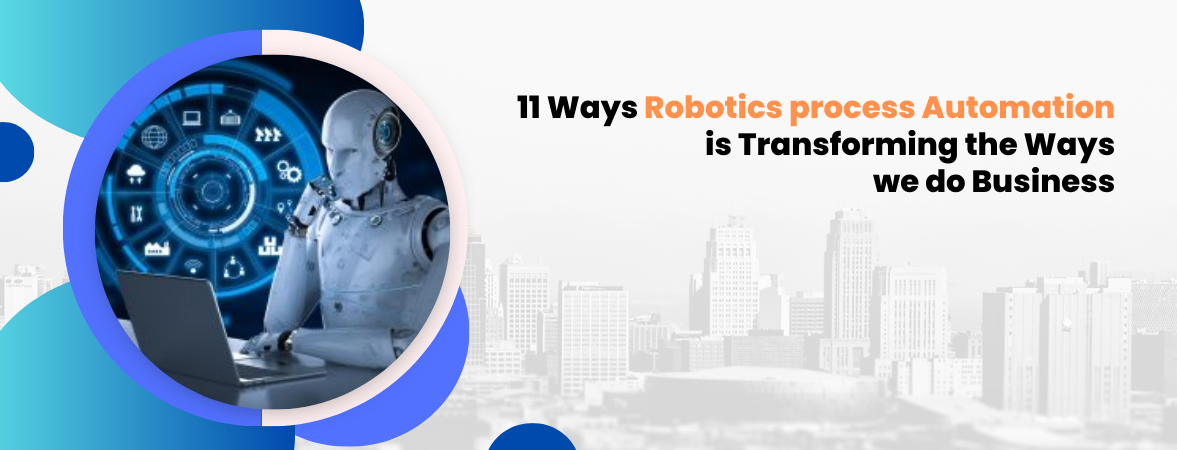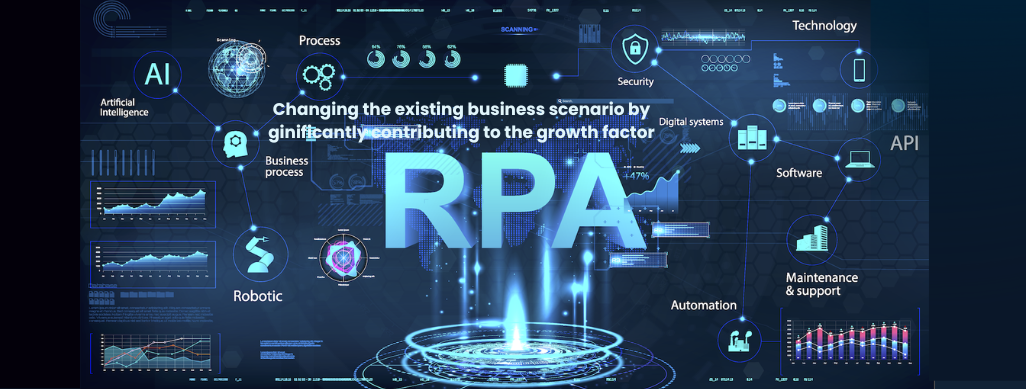
We use cookies to ensure that we give you the best experience on our website.
By using this site, you agree to our use of cookies. Find out more.
In this blog post merely scratch the surface of RPA's capabilities, and the future promises even more exciting advancements. Businesses that recognize the power of RPA and integrate it into their strategic roadmaps will be well-positioned to thrive in the digital age, leaving their mark on the transformative journey that lies ahead.

In the ever-evolving business landscape, where agility, efficiency, and innovation are paramount, Robotics Process Automation (RPA) has emerged as a game-changing technology, redefining the way we approach and execute business operations. This cutting-edge solution has the power to transform virtually every aspect of an organization, from streamlining processes and reducing costs to empowering employees and enhancing customer experiences. As businesses strive to stay ahead of the curve, RPA has become an indispensable tool, enabling them to unlock new levels of productivity, insights, and competitive advantages. Explore the following 11 ways in which RPA is revolutionizing the way we do business, ushering in a new era of operational excellence and unprecedented growth opportunities.
Robotics Process Automation (RPA) is a revolutionary technology that allows businesses to automate tedious, repetitive, and rule-based tasks through software robots or digital workers. These software bots are programmed to mimic human actions and interactions within computer systems, applications, and software, effectively taking over manual and time-consuming processes.
RPA operates by mapping a process, capturing the necessary data, and then replicating the human actions required to complete the task. It interacts with various applications and systems just like a human would, following predefined rules and logic. The software robots can perform tasks such as data entry, data processing, report generation, and even complex decision-making processes. RPA is designed to work seamlessly across multiple platforms, applications, and systems, making it a versatile solution for automating a wide range of business processes. By leveraging RPA, organizations can achieve significant efficiency gains, reduce operational costs, minimize errors, and reallocate human resources to more strategic and value-adding activities.
Here is how RPA is changing the existing business scenario by significantly contributing to the growth factor:

One of the most compelling advantages of Robotics Process Automation (RPA) is its ability to significantly reduce operational costs for businesses. By automating repetitive and time-consuming tasks, RPA eliminates the need for human intervention, resulting in substantial cost savings. Organizations can reallocate resources previously dedicated to manual labor towards more strategic initiatives, thereby optimizing their workforce utilization. Additionally, RPA solutions require minimal upfront investment compared to traditional automation methods, making it an attractive option for businesses of all sizes. With reduced labor costs, increased productivity, and streamlined processes, RPA empowers organizations to achieve greater profitability and a competitive edge in their respective markets.
Robotics Process Automation (RPA) plays a pivotal role in empowering employees by freeing them from mundane and repetitive tasks, allowing them to focus on more strategic and value-adding activities. By delegating routine processes to software robots, organizations can leverage the full potential of their human workforce. Employees are liberated from tedious tasks, enabling them to channel their energy, creativity, and cognitive abilities towards higher-level responsibilities that require critical thinking, problem-solving, and decision-making skills. This shift not only enhances job satisfaction and employee engagement but also fosters a culture of continuous learning and professional development. Empowered employees are more motivated, productive, and better equipped to drive innovation, ultimately contributing to the overall success and growth of the organization.
Robotics Process Automation (RPA) provides organizations with enhanced operational and business control, enabling them to streamline processes, improve governance, and maintain regulatory compliance more effectively. With RPA, businesses can establish standardized workflows, ensuring consistency and adherence to predefined rules and procedures. This level of control minimizes the risk of errors, deviations, or non-compliance issues that may arise from manual interventions. Furthermore, RPA solutions offer comprehensive auditing and reporting capabilities, providing real-time visibility into process performance, bottlenecks, and areas for improvement. This valuable insight empowers organizations to make data-driven decisions, optimize resource allocation, and maintain tight control over their operations, ultimately contributing to better business outcomes and a competitive edge in the market.
Robotics Process Automation (RPA) plays a crucial role in enhancing cycle time, a critical factor in today's fast-paced business environment. By automating repetitive and time-consuming tasks, RPA significantly reduces the processing time required for various operations. Software robots can work around the clock, without breaks or fatigue, ensuring continuous and uninterrupted workflow. This increased speed and efficiency enable organizations to accelerate their overall business processes, resulting in faster turnaround times for customers and stakeholders. Additionally, RPA eliminates the delays and bottlenecks often associated with manual processes, allowing for seamless and streamlined operations. By enhancing cycle time, businesses can improve their responsiveness, meet deadlines more efficiently, and ultimately gain a competitive advantage by delivering products or services to the market faster than their competitors.
By automating repetitive tasks, RPA generates a wealth of data that can be leveraged for comprehensive analysis and decision-making. The software robots meticulously record and log every action taken, providing organizations with a detailed audit trail and granular data insights. This wealth of information can be used to identify patterns, uncover process inefficiencies, and pinpoint areas for optimization. Furthermore, RPA systems can be integrated with advanced analytics tools, enabling businesses to generate real-time reports, visualizations, and predictive models. These insights empower organizations to make data-driven decisions, continuously improve processes, and gain a competitive edge by identifying new opportunities for growth and innovation.
Robotics Process Automation (RPA) has revolutionized the way businesses handle complex processes, making them simpler and more flexible. By breaking down intricate procedures into smaller, manageable tasks, RPA simplifies even the most convoluted workflows. Software robots can seamlessly navigate through multiple systems, applications, and data sources, streamlining the integration of disparate processes.
Moreover, RPA offers unparalleled flexibility, allowing organizations to easily modify and adapt their automated processes to accommodate changing business requirements or market dynamics. Unlike traditional automation methods, which often require extensive coding and system overhauls, RPA solutions can be reconfigured swiftly, minimizing disruptions and enabling rapid response to evolving needs. This agility empowers businesses to remain competitive, responsive, and resilient in the face of constantly shifting landscapes, ultimately driving efficiency and success in managing complex operations.
It offers businesses a compelling return on investment (ROI) by delivering substantial cost savings, increased productivity, and operational efficiencies. By automating labor-intensive and repetitive tasks, RPA significantly reduces the need for human involvement, resulting in substantial cost reductions in terms of labor expenses, training, and overhead costs. Additionally, the streamlined processes and optimized workflows enabled by RPA lead to higher productivity levels, translating into increased output and revenue generation.
Furthermore, RPA solutions typically require lower upfront investment compared to traditional automation methods, while offering faster implementation and shorter payback periods. By leveraging RPA, organizations can achieve quick wins and realize a better return on their investment, making it an attractive proposition for businesses seeking to optimize their operations and drive profitability.
(RPA) serves as a catalyst for businesses to chart a comprehensive digital roadmap, enabling them to embrace the digital transformation journey. By automating manual and repetitive tasks, RPA frees up valuable resources that can be redirected towards strategic digital initiatives. This allows organizations to focus on leveraging emerging technologies, such as artificial intelligence, machine learning, and advanced analytics, to drive innovation and gain a competitive edge.
Moreover, RPA provides a solid foundation for scaling and integrating future digital solutions, facilitating seamless connectivity and data exchange across various systems and platforms. By incorporating RPA into their digital roadmap, businesses can streamline their operations, enhance customer experiences, and unlock new revenue streams, ultimately positioning themselves as agile and future-ready entities in the ever-evolving digital landscape.
Robotics Process Automation (RPA) has the potential to significantly enhance customer experience by streamlining processes and improving service delivery. With RPA, businesses can automate tasks that directly impact customer interactions, such as data entry, order processing, and information retrieval. By eliminating manual errors and reducing processing times, RPA ensures faster and more accurate responses to customer inquiries and requests.
Moreover, RPA enables businesses to provide consistent and personalized experiences across multiple channels, whether it's through websites, mobile applications, or customer service representatives. By automating repetitive tasks, customer-facing employees can dedicate more time and attention to addressing unique customer needs, providing tailored solutions, and fostering stronger relationships. Ultimately, RPA empowers organizations to deliver seamless, efficient, and satisfying customer experiences, driving customer loyalty and competitive advantage in today's customer-centric market.
Robotics Process Automation (RPA) significantly improves accuracy in business processes, minimizing the risk of errors that often arise from manual interventions. Software robots are programmed to execute tasks precisely according to predefined rules and workflows, eliminating the potential for human error caused by fatigue, distractions, or lapses in concentration.
RPA solutions meticulously follow every step of a process, ensuring consistent and reliable outcomes. This level of accuracy is particularly crucial in industries such as finance, healthcare, and manufacturing, where even minor errors can have severe consequences. By automating critical tasks with RPA, businesses can enhance data integrity, reduce costly mistakes, and maintain stringent compliance standards. Improved accuracy not only boosts operational efficiency but also instills confidence in stakeholders, customers, and regulatory bodies, ultimately strengthening the organization's reputation and credibility.
Robotics Process Automation (RPA) plays a pivotal role in promoting agility within organizations, enabling them to adapt quickly to changing market dynamics and customer demands. By automating mundane and repetitive tasks, RPA frees up valuable resources that can be redirected towards strategic initiatives, fostering a more agile and responsive business environment.
Moreover, RPA solutions can be rapidly deployed and reconfigured to accommodate new processes or modifications, providing businesses with the flexibility to respond swiftly to evolving requirements. This agility empowers organizations to seize new opportunities, pivot their strategies, and stay ahead of the competition in today's fast-paced business landscape. By embracing RPA, companies can foster a culture of continuous improvement, encouraging innovation and enabling them to adapt and thrive in an ever-changing market, ultimately driving long-term success and sustainable growth.
The transformative potential of Robotics Process Automation services is undeniable, and its impact on the business world is already being felt across industries. By embracing RPA, organizations can unlock a realm of possibilities, from streamlining operations and reducing costs to empowering employees and delivering exceptional customer experiences. As technology continues to evolve, the role of RPA will become increasingly pivotal, enabling businesses to stay agile, efficient, and competitive in an ever-changing market. The 11 ways outlined in this blog post merely scratch the surface of RPA's capabilities, and the future promises even more exciting advancements. Businesses that recognize the power of RPA and integrate it into their strategic roadmaps will be well-positioned to thrive in the digital age, leaving their mark on the transformative journey that lies ahead.
Leave a Comment
Your email address will not be published.